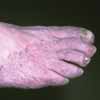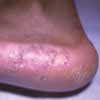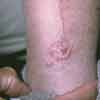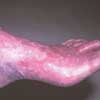- Clinical Technology
- Adult Immunization
- Hepatology
- Pediatric Immunization
- Screening
- Psychiatry
- Allergy
- Women's Health
- Cardiology
- Pediatrics
- Dermatology
- Endocrinology
- Pain Management
- Gastroenterology
- Infectious Disease
- Obesity Medicine
- Rheumatology
- Nephrology
- Neurology
- Pulmonology
Tinea Pedis in an 82-Year-Old Woman and Lupus Erythematosus
What is the most likely cause of these painful plantar ulcers? Can youidentify this well-demarcated rash that arose at the site of vein grafting?

Case 1:
An 82-year-old woman presents with a mildly pruritic rash on her feet. She purchased new shoes recently, but they are the same brand as those she had worn before. Her only medications are warfarin and atorvastatin.
What is your clinical impression?
A. Tinea pedis.
B. Contact dermatitis.
C. Pitted keratolysis.
D. Psoriasis.
E. Stasis dermatitis.

Case 1: Tinea pedis
A markedly positive potassium hydroxide (KOH) examination confirmed the diagnosis of a dermatophyte infection (tinea pedis, A). The patient was given a topical antifungal cream as well as an antifungal powder, and the rash resolved uneventfully.
Contact dermatitis usually appears on the dorsum of the foot, but the lesions are not as well demarcated as those seen here. Pitted keratolysis is confined to the sole. Psoriasis is a possibility if the KOH examination is negative. Stasis dermatitis is typically not confined to the foot.

Case 2:
For several years, a 39-year-old woman has had painful lesions on her feet that make it difficult for her to walk. She has systemic lupus erythematosus (SLE), which is treated with prednisone and mycophenolate mofetil.
What is the likely cause of these lesions?
A. Lupus erythematosus.
B. Tinea pedis exacerbated by immunosuppression.
C. Candidiasis exacerbated by immunosuppression.
D. Pitted keratolysis exacerbated by immunosuppression.
E. Plantar warts exacerbated by immunosuppression.

Case 2: Lupus erythematosus
These lesions represent cutaneous changes of SLE, A; the underlying disease was not adequately controlled by the patient's immunosuppressive medications. Rather than increase the dosages of these drugs, dapsone was added to the regimen. Over a 2-month period, the lesions markedly regressed, and the patient was able to walk without pain.
Vasculitic lesions can result in tender, "punched-out" ulcers that heal with scarring. They are not pathognomonic for SLE; thus, a biopsy may be necessary to confirm the diagnosis. Infections are always a concern in immunosuppressed patients, and biopsy or appropriate cultures are warranted if the diagnosis is in doubt.

Case 3:
A 77-year-old man seeks evaluation of a slightly pruritic rash that appeared at the site of vein grafting for bypass surgery, which he underwent 2 months earlier. He takes several antihypertensive agents but is unable to recall their names.
What are you looking at here?
A. Tinea corporis.
B. Nummular eczema.
C. Contact dermatitis.
D. Stasis dermatitis.
E. Psoriasis.

Case 3: Stasis dermatitis
A localized form of stasis dermatitis, D, and pitting edema developed after vein grafting. The patient was advised to wear support hose and to apply a mid-potent topical corticosteroid. Because some antihypertensive agents can cause water retention, the addition of a diuretic could be helpful.
Tinea corporis is possible, but it is usually expanding and more pruritic than the lesion seen here; a potassium hydroxide examination would rule it out. Nummular eczema is another possibility, although it is rarely confined to a single lesion. The patient had no history of exposure to a contactant; moreover, the lesions associated with contact dermatitis are generally not as well demarcated as this rash. Psoriasis is also possible, although a solitary lesion in this location would be unlikely.

Case 4:
About 2 to 3 weeks after an 83-year-old woman underwent a knee replacement, pruritic rashes developed on her left foot and on both hands. She has not used any new soaps or worn any new clothing in recent months, and she is unaware of any exposure to contactants. She has not started any new medications, but she was exposed to unknown drugs during her hospitalization 2 months earlier for the knee operation.
Which of the following do you suspect?
A. Contact dermatitis.
B. Psoriasis.
C. Stasis dermatitis.
D. Drug reaction.
E. Dermatophyte infection.

Case 4: Stasis dermatitis, id reaction, psoriasis
Marked pitting edema, which developed after this patient's knee operation, resulted in stasis dermatitis, C. Subsequently, an id reaction occurred; in this poorly understood phenomenon, a sympathetic rash appears on the hands when a chronic dermatitis or infection (such as a fungal infection) is present on the feet. A complicating factor in this patient was underlying psoriasis, B, which tends to manifest in inflamed skin (Koebner phenomenon).
A potassium hydroxide examination ruled out a dermatophyte infection. The absence of exposure to contactants and the distribution of the rash excluded contact dermatitis. A drug reaction would be more widespread.
A diuretic was prescribed for this patient, and she was told to wear support hose and to apply a topical corticosteroid cream. After about 2 weeks of treatment, the rashes cleared.
